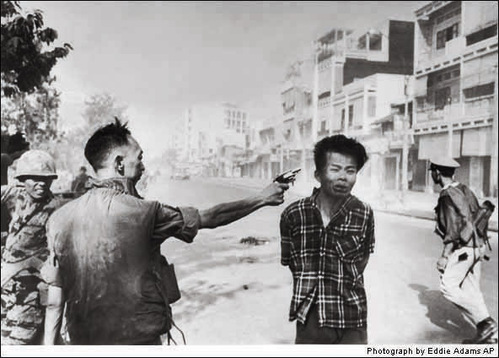On February 1, 1968, this famous photo was taken on a Saigon street.
Life Magazine places it in its list of "100 Photographs That Changed The World" and describes it this way:
With North Vietnam’s Tet Offensive beginning, Nguyen Ngoc Loan, South Vietnam’s national police chief, was doing all he could to keep Viet Cong guerrillas from Saigon. As Loan executed a prisoner who was said to be a Viet Cong captain, AP photographer Eddie Adams opened the shutter. Adams won a Pulitzer Prize for a picture that, as much as any, turned public opinion against the war. Adams felt that many misinterpreted the scene, and when told in 1998 that the immigrant Loan had died of cancer at his home in Burke, Va., he said, “The guy was a hero. America should be crying. I just hate to see him go this way, without people knowing anything about him.”
More background on the famous photo here:
The first 24 hours of the Tet Offensive were confusing. Vietcong had penetrated the city and were fighting inside the grounds of the U.S. embassy a few blocks away from the AP office. Eddie concentrated on that action on day one. Vietnamese photographers living across the city reported that Vietcong were fighting in their districts. It was not a time to venture out to find them. Most photos of this first day came from Vietnamese cruising the city on their motorbikes – including a 14-year-old boy photographer, Lo Hung, moving about on a bicycle and bringing back his films every few hours. Another youngster was Huynh Cong Ut, then 18, who was endearingly called Nick Ut by Eddie Adams.
But at the time, Eddie did not like the "kids’" competition.
On day two, news reports came in of fighting around a Buddhist pagoda (known for the monks’ opposition to the government) in an area where Saigon becomes Cholon, the Chinese section of the capital. Eddie teamed up with one of NBC’s most experienced cameramen – NBC was an office neighbor of AP and tips and transport were often shared. Eddie and Vo Su were driven slowly towards the area where fighting was reported, then walked when they found the streets had become abandoned and litter from a fight was visible.
The pagoda occupied by Viet Cong had been recaptured by Vietnamese marines. Hearing shots, they moved towards the action.
From a later interview Hal Buell, then Eddie’s boss in New York, reconstructed what happened next.
He wrote: "Adams watched as two Vietnamese soldiers pulled a prisoner out of a doorway at the end of the street. The soldiers then pushed and pulled what appeared to be a Viet Cong in a plaid shirt, his arms tied behind his back. They escorted the man toward the spot where Adams and Vo Su were located.
"Eddie Adams said, ‘I just followed the three of them as they walked towards us, making an occasional picture. When they were close – maybe five feet away – the soldiers stopped and backed away. I saw a man walk into my camera viewfinder from the left. He took a pistol out of his holster and raised it. I had no idea he would shoot. It was common to hold a pistol to the head of prisoners during questioning. So I prepared to make that picture – the threat, the interrogation. But it didn’t happen. The man just pulled a pistol out of his holster, raised it to the VC’s head and shot him in the temple. I made a picture at the same time.’
"The prisoner fell to the pavement, blood gushing," Buell wrote, quoting Eddie. "After a few more pictures of the dead man, Adams left."
The shooter was later identified as Lt. Colonel Nguyen Ngoc Loan, police chief of South Vietnam. Adams said he walked up to him and said, "They killed many of my people, and yours, too" and then just walked away.
Adams (who pased away in 2004) also reportedly said:
I won a Pulitzer Prize in 1969 for a photograph of one man shooting another…The general killed the Viet Cong; I killed the general with my camera. Still photographs are the most powerful weapon in the world. People believe them, but photographs do lie, even without manipulation. They are only half-truths. What the photograph didn’t say was, “What would you do if you were the general at that time and place on that hot day, and you caught the so-called bad guy after he blew away one, two or three American soldiers?” General Loan was what you would call a real warrior, admired by his troops. I’m not saying what he did was right, but you have to put yourself in his position.
General Loan died in 1998.
The famous picture, as well as video shot by NBC, was quickly shown around the world, and became a flash point for the peace movement. (The video, pulled from YouTube, is understandably graphic and difficult to watch).


